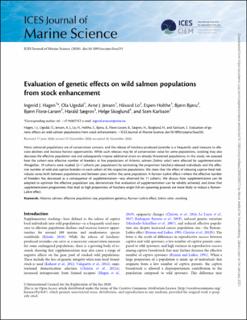| dc.contributor.author | Hagen, Ingerid Julie | |
| dc.contributor.author | Ugedal, Ola | |
| dc.contributor.author | Jensen, Arne Johan | |
| dc.contributor.author | Lo, Håvard | |
| dc.contributor.author | Holthe, Espen | |
| dc.contributor.author | Bjøru, Bjørn | |
| dc.contributor.author | Florø-Larsen, Bjørn | |
| dc.contributor.author | Sægrov, Harald | |
| dc.contributor.author | Skoglund, Helge | |
| dc.contributor.author | Karlsson, Sten | |
| dc.date.accessioned | 2023-03-03T12:05:45Z | |
| dc.date.available | 2023-03-03T12:05:45Z | |
| dc.date.created | 2021-01-04T15:20:19Z | |
| dc.date.issued | 2020 | |
| dc.identifier.issn | 1054-3139 | |
| dc.identifier.uri | https://hdl.handle.net/11250/3055738 | |
| dc.description.abstract | Many salmonid populations are of conservation concern, and the release of hatchery-produced juveniles is a frequently used measure to alleviate declines and increase harvest opportunities. While such releases may be of conservation value for some populations, stocking may also decrease the effective population size and subsequently impose additional strain on already threatened populations. In this study, we assessed how the cohort-wise effective number of breeders in five populations of Atlantic salmon (Salmo salar) were affected by supplementation. Altogether, 19 cohorts were studied (2–7 cohorts per population) by estimating the proportion hatchery-released individuals and the effective number of wild and captive breeders in each cohort of the respective populations. We show that the effect of releasing captive-bred individuals varies both between populations and between years within the same population. A Ryman–Laikre effect—where the effective number of breeders has decreased as a consequence of supplementation—was observed for 11 cohorts. We discuss how supplementation can be adapted to optimize the effective population size, demonstrate that evaluation of supplementation can be reliably achieved, and show that supplementation programmes that lead to high proportions of hatchery-origin fish on spawning grounds are more likely to induce a Ryman–Laikre effect. Atlantic salmon, effective population size, population genetics, Ryman–Laikre effect, Salmo salar, stocking | en_US |
| dc.language.iso | eng | en_US |
| dc.rights | Navngivelse 4.0 Internasjonal | * |
| dc.rights.uri | http://creativecommons.org/licenses/by/4.0/deed.no | * |
| dc.subject | Atlantic salmon | en_US |
| dc.subject | effective population size | en_US |
| dc.subject | population genetics | en_US |
| dc.subject | Ryman–Laikre effect | en_US |
| dc.subject | Salmo salar | en_US |
| dc.subject | stocking | en_US |
| dc.title | Evaluation of genetic effects on wild salmon populations from stock enhancement | en_US |
| dc.type | Peer reviewed | en_US |
| dc.type | Journal article | en_US |
| dc.description.version | publishedVersion | en_US |
| dc.rights.holder | © 2020 International Council for the Exploration of the Sea 2020 | en_US |
| dc.subject.nsi | VDP::Matematikk og Naturvitenskap: 400::Zoologiske og botaniske fag: 480 | en_US |
| dc.source.pagenumber | 900-909 | en_US |
| dc.source.volume | 78 | en_US |
| dc.source.journal | ICES Journal of Marine Science | en_US |
| dc.source.issue | 3 | en_US |
| dc.identifier.doi | 10.1093/icesjms/fsaa235 | |
| dc.identifier.cristin | 1865013 | |
| dc.relation.project | Andre: Flekke Elveeigarlag | en_US |
| dc.relation.project | Andre: Statkraft AS | en_US |
| dc.relation.project | Andre: Sognekraft AS | en_US |
| dc.relation.project | Egen institusjon: Norwegian institute for nature research (NINA) | en_US |
| dc.relation.project | Andre: Norwegian Environment Agency | en_US |
| cristin.ispublished | true | |
| cristin.fulltext | original | |
| cristin.qualitycode | 1 | |

